介孔及碳纳米材料
- 格式:ppt
- 大小:7.33 MB
- 文档页数:60
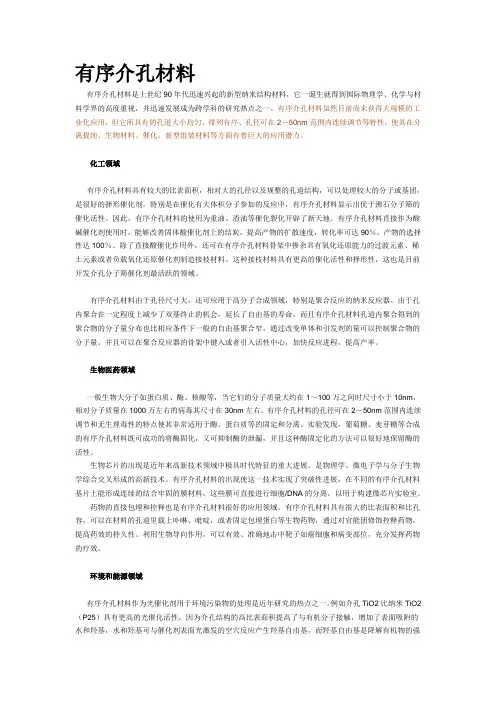
有序介孔材料有序介孔材料是上世纪90年代迅速兴起的新型纳米结构材料,它一诞生就得到国际物理学、化学与材料学界的高度重视,并迅速发展成为跨学科的研究热点之一。
有序介孔材料虽然目前尚未获得大规模的工业化应用,但它所具有的孔道大小均匀、排列有序、孔径可在2-50nm范围内连续调节等特性,使其在分离提纯、生物材料、催化、新型组装材料等方面有着巨大的应用潜力。
化工领域有序介孔材料具有较大的比表面积,相对大的孔径以及规整的孔道结构,可以处理较大的分子或基团,是很好的择形催化剂。
特别是在催化有大体积分子参加的反应中,有序介孔材料显示出优于沸石分子筛的催化活性。
因此,有序介孔材料的使用为重油、渣油等催化裂化开辟了新天地。
有序介孔材料直接作为酸碱催化剂使用时,能够改善固体酸催化剂上的结炭,提高产物的扩散速度,转化率可达90%,产物的选择性达100%。
除了直接酸催化作用外,还可在有序介孔材料骨架中掺杂具有氧化还原能力的过渡元素、稀土元素或者负载氧化还原催化剂制造接枝材料。
这种接枝材料具有更高的催化活性和择形性,这也是目前开发介孔分子筛催化剂最活跃的领域。
有序介孔材料由于孔径尺寸大,还可应用于高分子合成领域,特别是聚合反应的纳米反应器。
由于孔内聚合在一定程度上减少了双基终止的机会,延长了自由基的寿命,而且有序介孔材料孔道内聚合得到的聚合物的分子量分布也比相应条件下一般的自由基聚合窄,通过改变单体和引发剂的量可以控制聚合物的分子量。
并且可以在聚合反应器的骨架中键入或者引入活性中心,加快反应进程,提高产率。
生物医药领域一般生物大分子如蛋白质、酶、核酸等,当它们的分子质量大约在1~100万之间时尺寸小于10nm,相对分子质量在1000万左右的病毒其尺寸在30nm左右。
有序介孔材料的孔径可在2-50nm范围内连续调节和无生理毒性的特点使其非常适用于酶、蛋白质等的固定和分离。
实验发现,葡萄糖、麦芽糖等合成的有序介孔材料既可成功的将酶固化,又可抑制酶的泄漏,并且这种酶固定化的方法可以很好地保留酶的活性。
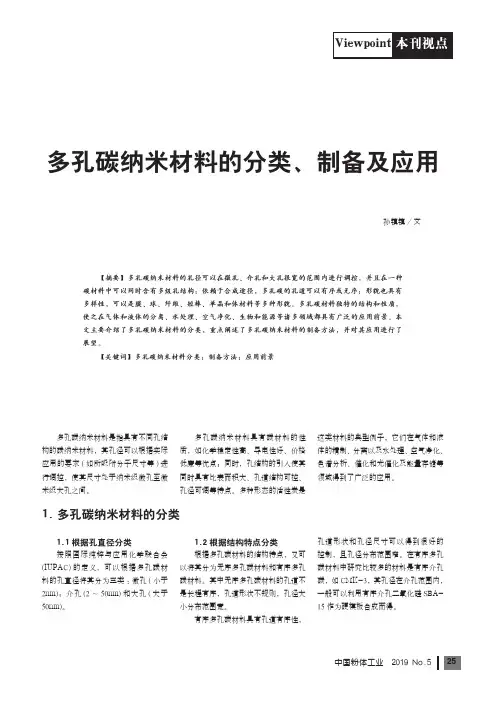
多孔碳纳米材料的分类、制备及应用孙镇镇/文【摘要】多孔碳纳米材料的孔径可以在微孔、介孔和大孔很宽的范围内进行调控,并且在一种碳材料中可以同时含有多级孔结构;依赖于合成途径,多孔碳的孔道可以有序或无序;形貌也具有多样性,可以是膜、球、纤维、短棒、单晶和体材料等多种形貌。
多孔碳材料独特的结构和性质,使之在气体和液体的分离、水处理、空气净化、生物和能源等诸多领域都具有广泛的应用前景。
本文主要介绍了多孔碳纳米材料的分类,重点阐述了多孔碳纳米材料的制备方法,并对其应用进行了展望。
【关键词】多孔碳纳米材料分类;制备方法;应用前景多孔碳纳米材料是指具有不同孔结构的碳纳米材料,其孔径可以根据实际应用的要求(如所吸附分子尺寸等)进行调控,使其尺寸处于纳米级微孔至微米级大孔之间。
多孔碳纳米材料具有碳材料的性质,如化学稳定性高、导电性好、价格低廉等优点;同时,孔结构的引入使其同时具有比表而积大、孔道结构可控、孔径可调等特点。
多种形态的活性炭是这类材料的典型例子,它们在气体和液体的精制、分离以及水处理、空气净化、色谱分析、催化和光催化及能量存储等领域得到了广泛的应用。
1.多孔碳纳米材料的分类1.1根据孔直径分类按照国际纯粹与应用化学联合会(IUPAC)的定义,可以根据多孔碳材料的孔直径将其分为三类:微孔(小于2nm);介孔(2~50nm)和大孔(大于50nm)。
1.2根据结构特点分类根据多孔碳材料的结构特点,又可以将其分为无序多孔碳材料和有序多孔碳材料。
其中无序多孔碳材料的孔道不是长程有序,孔道形状不规则,孔径大小分布范围宽。
有序多孔碳材料具有孔道有序性,孔道形状和孔径尺寸可以得到很好的控制,且孔径分布范围窄。
在有序多孔碳材料中研究比较多的材料是有序介孔碳,如CMK-3,其孔径在介孔范围内,一般可以利用有序介孔二氧化硅SBA-15作为硬模板合成而得。
25中国粉体工业 2019 No.52.多孔碳纳米材料的制备方法多孔碳纳米材料的制备方法较多,归纳起来有以下几类:2.1 模板法模板法是用已可直接制备材料的形貌来控制制备其他材料形貌的方法。
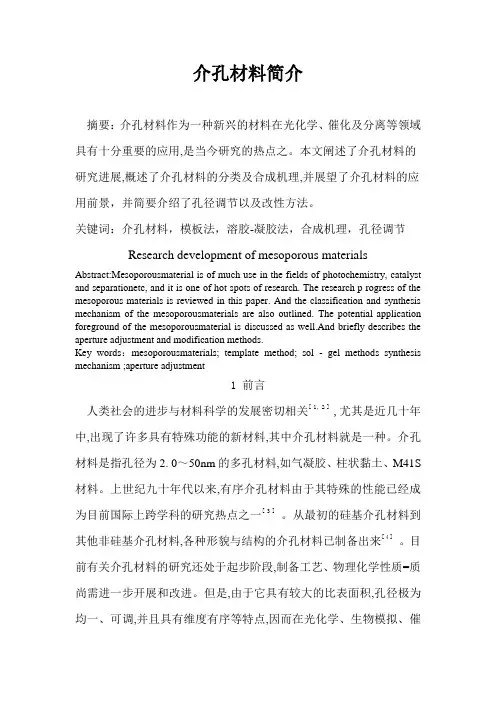
介孔材料简介摘要:介孔材料作为一种新兴的材料在光化学、催化及分离等领域具有十分重要的应用,是当今研究的热点之。
本文阐述了介孔材料的研究进展,概述了介孔材料的分类及合成机理,并展望了介孔材料的应用前景,并简要介绍了孔径调节以及改性方法。
关键词:介孔材料,模板法,溶胶-凝胶法,合成机理,孔径调节Research development of mesoporous materials Abstract:Mesoporousmaterial is of much use in the fields of photochemistry, catalyst and separationetc, and it is one of hot spots of research. The research p rogress of the mesoporous materials is reviewed in this paper. And the classification and synthesis mechanism of the mesoporousmaterials are also outlined. The potential application foreground of the mesoporousmaterial is discussed as well.And briefly describes the aperture adjustment and modification methods.Key words:mesoporousmaterials; template method; sol - gel methods synthesis mechanism ;aperture adjustment1 前言人类社会的进步与材料科学的发展密切相关[ 1, 2 ],尤其是近几十年中,出现了许多具有特殊功能的新材料,其中介孔材料就是一种。
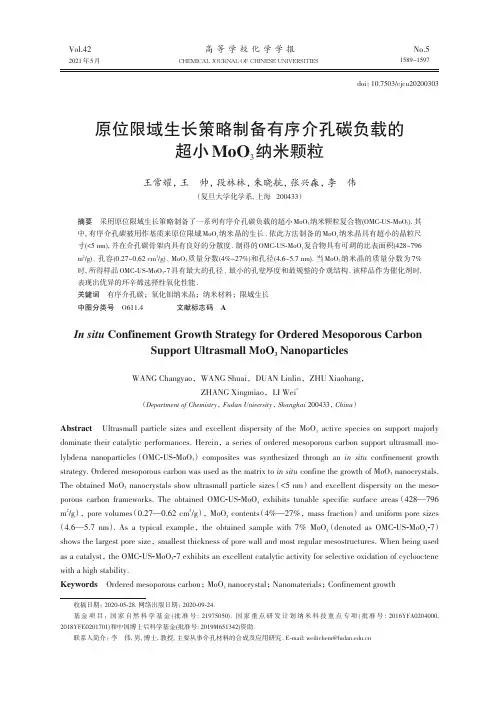
Vol.42 2021年5月No.51589~1597 CHEMICAL JOURNAL OF CHINESE UNIVERSITIES高等学校化学学报原位限域生长策略制备有序介孔碳负载的超小MoO3纳米颗粒王常耀,王帅,段林林,朱晓航,张兴淼,李伟(复旦大学化学系,上海200433)摘要采用原位限域生长策略制备了一系列有序介孔碳负载的超小MoO3纳米颗粒复合物(OMC-US-MoO3).其中,有序介孔碳被用作基质来原位限域MoO3纳米晶的生长.依此方法制备的MoO3纳米晶具有超小的晶粒尺寸(<5nm),并在介孔碳骨架内具有良好的分散度.制得的OMC-US-MoO3复合物具有可调的比表面积(428~796m2/g)、孔容(0.27~0.62cm3/g)、MoO3质量分数(4%~27%)和孔径(4.6~5.7nm).当MoO3纳米晶的质量分数为7%时,所得样品OMC-US-MoO3-7具有最大的孔径、最小的孔壁厚度和最规整的介观结构.该样品作为催化剂时,表现出优异的环辛烯选择性氧化性能.关键词有序介孔碳;氧化钼纳米晶;纳米材料;限域生长中图分类号O611.4文献标志码AIn situ Confinement Growth Strategy for Ordered Mesoporous CarbonSupport Ultrasmall MoO3NanoparticlesWANG Changyao,WANG Shuai,DUAN Linlin,ZHU Xiaohang,ZHANG Xingmiao,LI Wei*(Department of Chemistry,Fudan University,Shanghai200433,China)Abstract Ultrasmall particle sizes and excellent dispersity of the MoO3active species on support majorly dominate their catalytic performances.Herein,a series of ordered mesoporous carbon support ultrasmall mo⁃lybdena nanoparticles(OMC-US-MoO3)composites was synthesized through an in situ confinement growth strategy.Ordered mesoporous carbon was used as the matrix to in situ confine the growth of MoO3nanocrystals. The obtained MoO3nanocrystals show ultrasmall particle sizes(<5nm)and excellent dispersity on the meso-porous carbon frameworks.The obtained OMC-US-MoO3exhibits tunable specific surface areas(428―796 m2/g),pore volumes(0.27―0.62cm3/g),MoO3contents(4%―27%,mass fraction)and uniform pore sizes (4.6―5.7nm).As a typical example,the obtained sample with7%MoO3(denoted as OMC-US-MoO3-7)shows the largest pore size,smallest thickness of pore wall and most regular mesostructures.When being used as a catalyst,the OMC-US-MoO3-7exhibits an excellent catalytic activity for selective oxidation of cyclooctene with a high stability.Keywords Ordered mesoporous carbon;MoO3nanocrystal;Nanomaterials;Confinement growthdoi:10.7503/cjcu20200303收稿日期:2020-05-28.网络出版日期:2020-09-24.基金项目:国家自然科学基金(批准号:21975050)、国家重点研发计划纳米科技重点专项(批准号:2016YFA0204000, 2018YFE0201701)和中国博士后科学基金(批准号:2019M651342)资助.联系人简介:李伟,男,博士,教授,主要从事介孔材料的合成及应用研究.E-mail:*******************.cn1590Vol.42高等学校化学学报Epoxides,an important industrial chemicals,has been widely used in the fields of food additives,phar⁃maceutical intermediates,etc.[1,2].Catalytic epoxidation of olefin is one of the essential route to produce epo-xides,which oxygenation of carbon-carbon double bond to form cyclic epoxide groups.The kind of catalyst plays a key role on the epoxidation reaction.Among all catalysts,precious metal of gold based one illustrates high activity for olefin epoxidations[3,4].However,gold is limited resource and very expensive,even though it shows high conversion efficiency.Molybdenum oxide(MoO3),as one of the low cost,non-toxic and environ⁃mentally benign transition metal oxides,is widely used as heterogeneous catalysis for Friedel-Crafts alkyla⁃tion[5],hydrogenation reaction[6,7],epoxidation reaction[8,9],hydrogen evolution reaction[10],electrochemical energy storage for lithium-ion batteries[11,12],and gas sensors[13,14],etc..Gratifyingly,MoO3has been reported by several groups which have high activity for epoxidation of olefins in recent years[15,16].It is obvious that the size and morphology of MoO3active species are critical factors that affect their prop⁃erties for application[17~20].However,the synthesis and reaction process often easily causes serious sintering,migration and agglomeration of the MoO3nanoparticles,leading to the degradation of catalytic activity.Sup⁃ports are necessary for the immobilization of active species.Carbon has been widely used as an outstanding matrix to control the size and dispersity of supported metal oxides attributing to its advantages of intrinsical chemical inertness,high thermal stability,non-toxic and wide-sources[21~23].Molybdena supported carbon have been reported and show excellent performance as the catalyst for cyclooctene epoxidation[24,25].Recently,Chen group[26]fabricatedγ-Fe2O3@C@MoO3core-shell structured nanoparticles as a magnetically recyclable catalyst for the epoxidation reaction of olefins.The coated carbon layer play an efficient role for the stabiliza⁃tion of magnetic core.Biradar group[8]also reported a carbon microspheres-supported molybdena nanoparticles catalyst which also show outstanding effect for the epoxidation of olefins.However,above-mentioned catalysts are less porosity.Porous supports,especially,mesoporous carbon have been reported on many catalytic areas because of its large surface area,pore volume and pore size,which can not only improve the load capacity but also enlarge the reaction progress,where the diffusion process may be the rate-limiting step[26~28].Up to now,it is still urgent to fabricate mesoporous carbon supported MoO3catalyst with ultrasmall particle size and excel⁃lent dispersity.Herein,we construct an ordered mesoporous carbon support ultrasmall MoO3nanoparticles(OMC-US-MoO3)composites via an in situ confinement growth strategy.In this strategy,the ordered mesoporous carbon works as a matrix to in situ confine the growth of MoO3nanocrystals.The obtained MoO3nanocrystals show ultrasmall particle size(<5nm)and excellent dispersity on the mesoporous carbon frameworks.The content (mass fraction)of MoO3can be tuned from4%to27%.The obtained OMC-US-MoO3shows tunable specific surface areas(428―796m2/g),pore volumes(0.27―0.62cm3/g)and uniform pore size(4.6―5.7nm).As a typical example,the obtained sample with7%MoO3(denoted as OMC-US-MoO3-7)shows largest pore size,smallest thickness of pore wall and most regular mesostructures.When being used as a catalyst,the OMC-US-MoO3-7exhibits an excellent catalytic activity for selective oxidation of cyclooctene with a high stability.1Experimental1.1Chemicals and MaterialsPluronic F127(EO106PO70EO106,M w=12600)was purchased from Aldrich.All others chemicals were obtained from Aladdin company and used directly.Deionized water was used in all experiments.1.2Synthesis of Ordered Mesoporous Carbon Support Ultrasmall Molybdena NanoparticlesIn detail synthesis procedure,1.0g of Pluronic F127powders was added into10.0g of ethanol solution and stirred to a homogeneous clear solution at40℃.Afterwards,5.0g of20%(mass fraction)preformedNo.5王常耀等:原位限域生长策略制备有序介孔碳负载的超小MoO 3纳米颗粒phenolic resins ethanol solution and 1.0mL of peroxomolybdenum precursor solution were added into the ho⁃mogeneous system (5—200mg/mL ).The preformed phenolic resins was synthesized based on the reported method [27,28].Peroxomolybdenum precursor solution [29]was prepared by dissolving different contents of molyb⁃denum trioxide into 10.0mL of 30%hydrogen peroxide.The mixture solution was poured into dishes after 2h and then the dishes were heat treated at 40and 100℃for 8and 20h ,respectively ,forming the as -made com⁃posites consisting of Pluronic F127,phenolic resins ,and Mo species (denoted as as -made sample ).Then ,the calcination of as -made sample was implemented in a tubular furnace under N 2atmosphere.The temperature program was set from 25℃to 350℃with a ramp of 1℃/min ,maintenance for 3h ,and then to 600℃with 1℃/min ,maintenance for 2h.The obtained sample after pyrolysis was named as ordered mesoporous carbon support ultrasmall molybdena nanoparticles (OMC -US -MoO 3-x ),wherein x represent the actual mass fraction of MoO 3.1.3Activity Test The selective oxidation reaction of cyclooctene was carried out in the round -bottom flask (50mL ).In which ,40.0mmol of cyclooctene ,40.0mmol of 5.5mol/L TBHP in decane ,10mg of OMC -US -MoO 3-7cata⁃lyst (0.0048mmol/L of MoO 3),6.0g of 1,2-dichloroethane as solvent ,and 15.0mmol of chlorobenzene as internal standard.The reaction temperature is 80℃.At different time intervals ,conversion was calculated by sampling.The samples were analyzed on an Agilent 7890A gas chromatograph equipped with a HP -5column and products were confirmed by GC -MS.TOF values (mol of reacted cyclooctene per mol of catalyst and hour )was calculated at about half conversion of the reaction.The catalyst was reused after washing by water and drying.The test condition was kept same to the first time on the cyclic test.2Results and Discussion2.1Synthesis and CharacterizaitonThe developed in situ confinement growth strategy is employed to the preparation of ordered mesoporous carbon support ultrasmall molybdena nanoparticles (OMC -US -MoO 3)composites (Fig.1).In the synthesis sys⁃tem ,Pluronic F127is used as the structure -directing agent (soft -template ),preformed phenolic resins is used as carbon resource ,peroxomolybdenum solution is used as precursor ,and ethanol/H 2O is used as co -solvent ,respectively.The as -made sample and product OMC -US -MoO 3composites can be obtained after heat -treatment at 100and 600℃,respectively.The mass content of MoO 3in the OMC -US -MoO 3composites can be well tuned through adjusting the amount of peroxomolybdenum precursor in the synthesis system.TGA curves (Fig.2)show that the mass fractions of MoO 3species in the OMC -US -MoO 3composites areFig.1Illustration of the construction of OMC ⁃US ⁃MoO 3composites via the in situ confinementgrowth strategy Fig.2TGA curves of the OMC ⁃US ⁃MoO 3composites with different MoO 3contents obtained afterpyrolysis at 600℃,respectivelyMass fraction of MoO 3(%):a .4;b .7;c .10;d .16;e .27.1591Vol.42高等学校化学学报4%,7%,10%,16%and 27%(Table 1),respectively ,when adjusting the amount of molybdenum precursors in the synthesis system.The mass loss below 100℃is caused by the volatilization of adsorbed water in the composites.A slight mass increasement can be detected between 100and 300℃,demonstrating the existence of trace amount of MoO 2and abundant MoO 3in the composites.The mass increasement can be attributed to the oxidation of the trace amount MoO 2.Subsequently ,the huge mass loss above 300℃can be observed attribu -ting to the remove of carbon species in the composites.The mass loss between 100and 600℃is approximate to the mass fraction of MoO 3species in the composites.The SAXS patterns [Fig.3(A )]of OMC -US -MoO 3-4and OMC -US -MoO 3-7composites show two scatteringdiffraction peaks at 0.391and 0.782nm −1,and 0.412and 0.824nm ‒1,respectively ,indexing to the (100)and (200)reflections of a hexagonal mesosturtures with space group P 6mm .With the increasement of MoO 3content ,the q values of the (100)diffraction peaks shift to 0.532,0.617,and 0.678nm −1,for samples OMC -US -MoO 3-10,OMC -US -MoO 3-16,and OMC -US -MoO 3-27,respectively.The corresponding cell parame⁃ters of five composites are calculated to be about 18.5,17.6,13.6,11.7,and 10.7nm with the increased MoO 3content ,respectively.WAXRD patterns [Fig.3(B )]of five composites all show no diffraction peaks of MoO 3phase ,suggesting the ultrasmall particle size of MoO 3nanocrystals in the frameworks.This result demonstrates that the ordered mesoporous carbon frameworks can confine the size of MoO 3nanocrystals to an ultrasmall size even at a high MoO 3content effectively.Nitrogen adsorption -desorption isotherms of five OMC -US -MoO 3composites obtained after calcined at 600℃in N 2all display representative type -Ⅳcurves with H2hysteresis loops [Fig.4(A )],in agreement with the previously reported ordered mesoporous materials [30~32].Sharp capillary condensation steps in the relative pressure (p /p 0)of 0.41―0.70are observed for five composites ,demonstrating the narrow pore size distribu⁃tion.The Brunauer -Emmett -Teller (BET )surface area and pore volume of five composites are calculated and listed on Table 1.The surface area and pore volume decrease with the increased MoO 3content ,which can be attributed to the partial destroy and disappear of pore structures.The average pore sizes of five composites are also calculated and listed on Table 1from their pore size distribution curve [Fig.4(B )]derived from the adsorption branch based on BJH model.The average pore sizes are 4.7,5.7,5.5,5.4,and 4.6nm ,Table 1Structural and textural parameters for OMC -US -MoO 3with different content Sample No.12345MoO 3content (%,mass fraction )47101627S BET /(m 2·g -1)796693652574428V /(cm 3·g -1)0.620.540.490.410.27D /nm 4.75.75.55.4 4.6Fig.3SAXS(A)and WA ⁃XRD(B)patterns of the OMC ⁃US ⁃MoO 3composites with differentMoO 3contents obtained after pyrolysis at 600℃Mass fraction of MoO 3(%):a .4;b .7;c.10;d .16;e .27.1592No.5王常耀等:原位限域生长策略制备有序介孔碳负载的超小MoO 3纳米颗粒respectively.According to the cell parameters results ,the pore walls of five composites are calculated to be 14.1,11.9,8.1,6.3,and 6.1nm ,respectively.SEM images (Fig.5)show that OMC -US -MoO 3-4and OMC -US -MoO 3-7composites own the most regular mesostructures.Notably ,the regular [100]and [110]directions can be clear observed from the SEM images of OMC -US -MoO 3-7composites [Fig.5(B )and (F )].In addition ,the mesopores are opened and no obvious big metal nanoparticles can be observed from the surface.With further increasement of MoO 3content ,the reg⁃ular mesostructures is partial destroyed.TEM images of OMC -US -MoO 3-7composites [Fig.6(A )—(C )]taken along the [100]and [110]directions manifest a well -defined 2D hexagonal mesostructures in agreement with the result of the SAXS pattern [Fig.2(A )].The lattice spacing is measured to be 0.35nm from the HRTEM image [Fig.6(D )],attributing to the (040)crystalline planes of α-MoO 3[33].The average size of MoO 3nano⁃crystals is estimated to be (4.1±1.0)nm from the size statistics diagram.The survey spectrum of the OMC -US -MoO 3-7composites shows the presence of only Mo ,O and C elements [Fig.7(A )].The high -resolution Mo 3d core level XPS spectra [Fig.7(B )]show four peaks at 230.5,232.7,233.6,and 235.9eV ,demon⁃strating the co -existence of Mo 4+and Mo 6+species [34~36].The ratio of Mo 4+/Mo 6+is calculated to be about 13%.Only a few Mo 4+signals can be detected from the spectrum ,in agreement with the TGAresults.Fig.4N 2adsorption⁃desorption isotherms(A)and pore size distributions(B)of the OMC⁃US⁃MoO 3composites with different MoO 3contents obtained after pyrolysis at 600℃Mass fraction of MoO 3(%):a .4;b .7;c.10;d .16;e .27.Fig.5SEM images of OMC⁃US⁃MoO 3composites with different MoO 3contents obtained afterpyrolysis at 600℃Mass fraction of MoO 3(%):(A)4;(B)7;(C)10;(D)16;(E)27.1593Vol.42高等学校化学学报2.2Formation Mechanism Studies Based on the above results ,we propose that the in situ confinement growth strategy show significant impact on the formation of final OMC -US -MoO 3composites.The obtained MoO 3nanocrystals show ultrasmall particle size (<5nm )and excellent dispersity on the mesoporous carbon frameworks.This structure can be retained even the mass fraction of MoO 3is increased to 27%.However ,the regular mesostructures can be partial destroyed with the increased MoO 3mass content.According to the results that no large MoO 3nanocrys⁃tals can be detected from samples obtained after pyrolysis at 600℃,the unregular mesostructures can be attributed to the uncontrollable origin co -assembly process.2.3Selective Oxidation of Cyclooctene The selective oxidation reaction of cyclooctene with high catalytic performance and stability is still highly desired.However ,the stability of active nanoparticles in catalytic reaction is a major challenge ,especially for active nanoparticles with ultra -small size.For our case ,the OMC -US -MoO 3-7composites show most regular mesostructures ,largest pore sizes ,appropriate hole wall size ,MoO 3content and dispersity.So ,the obtained OMC -US -MoO 3-7composites catalyst is selected as the catalyst for cyclooctene epoxidation.The reactions were carried out using 1,2-dichloroethane as solvent in flask with chlorobenzene as internal standard at 80℃.The OMC -US -MoO 3-7composites catalyst shows a high TOF value of 2163h ‒1which is calculated on the basis of the experimental data at 2h.Meanwhile ,a high conversion (100%)of cyclooctene ,and selectivity (>99%)to 1,2-epoxycyclooctane at 8h can also be parison with the reported heterogeneous Mo -based catalyst using similar conditions was shown in Table 2.The present OMC -US -MoO 3-7catalystshowsFig.7Survey XPS spectrum(A)and high⁃resolution XPS spectra of Mo 3d (B)for OMC⁃US⁃MoO 3⁃7composites obtained after pyrolysis at 600℃Fig.6TEM images of OMC⁃US⁃MoO 3⁃7composites obtained after pyrolysis at 600℃Viewed along the hexagonal (A )and columnar (B ,C )directions and HRTEM image (D )of a representative MoO 3nanoparticle.1594No.5王常耀等:原位限域生长策略制备有序介孔碳负载的超小MoO 3纳米颗粒a higher TOF value than MoO 3/C [8],MoO 3/SiO 2[37],Mo -MOFs [9],Mo -MCM -41[38],Mo -SBA -15[38],[Pipera⁃zinCH 2{MoO 2(Salen )}]n [39],and MNP 30-Si -inic -Mo [40]as previous reported.It should be noted that cyclooc⁃tene still gave about 18%conversion [Fig.8(A )]in the absence of catalyst owing to the presence of strong TBHP oxidants ,which is consistent with previous reports [41,42].Further ,two other substrates ,cyclohexene and styrene were also tested under the same conditions to test the versatility of OMC -US -MoO 3-7as an epoxida⁃tion catalyst.Surprisingly ,the conversion of cyclohexene to 1,2-epoxyclohexane can reach 54%in 8h.Inaddition ,the conversion of styrene to styrene oxide can reach 95%in 36h ,respectively (Fig.S1,see the Sup⁃porting Information of this paper ).Beside the efficient conversion of catalyst and high TOF values ,the stability of catalyst is also very impor⁃tant ,especially for heterogeneous catalysis.Here ,the hot filtration test was used to assess the presence of active Mo species in solution.When the reaction lasted for 2h ,we removed the catalyst by hot filtration and let the mother liquid for reacting another 6h.The results showed that there was only a slight increase in con⁃version [Fig.8(A )],which is proof of a heterogeneous catalysis.For the recycling study ,cyclooctene epoxida⁃tion was performed maintaining the same reaction conditions except using the recovered catalyst.It can be clearly found that obvious changes are undetected for catalytic performance after five runs [Fig.8(B )].It indi⁃cates that ultrasmall MoO 3nanoparticles supported on ordered mesoporous carbon is highly stable and can be reused ,demonstrates its potential for industrial applications.The high conversion ,selectively ,and the TOF value for the cyclooctene epoxidation reaction can be attributed to the unique structure of the OMC -US -MoO 3-7composites.The high surface area ,volume ,andTable 2Calculating TOF value for epoxidation of cyclooctene and comparing with other catalysts *Catalyst OMC -US -MoO 3-7MoO 3/C MoO 3/SiO 2Mo -MOFs Mo -MCM -41Mo -SBA -15[PiperazinCH 2{MoO 2(Salen )}]n MNP 30-Si -inic -MoTime/h 2267331224Conv.(%)5280909397999546Epoxide sel.(%)>9910010099959398100TOF/h -1216353[8]72[35]270[9]22[36]40[36]16[37]2[38]*.TOF values(mol of reacted cyclooctene per mol of catalyst and hour)were calculated at abouthalf conversion of the reaction.Fig.8Time course plots of cyclooctene epoxidation(A)and reusability(B)by using OMC⁃US⁃MoO 3⁃7com⁃posites as catalystReaction conditions :40.0mmol of cyclooctene ,40.0mmol of 5.5mol/L TBHP in decane ,10mg of OMC -US -MoO 3-7catalyst (0.0048mmol/L of MoO 3),6.0g of 1,2-dichloroethane as solvent ,and 15.0mmol of chlorobenzene as internalstandard.The reaction temperature is 80℃.15951596Vol.42高等学校化学学报uniform mesopores can not only enrichment the reaction substrate but also in favor to the diffusion of sub⁃strates.The ultrasmall MoO3nanocrystals size and its excellent dispersity in the frameworks can expose more active sites.All these features are beneficial to the rapid conversion of substrate molecular with high selective⁃ly and conversion.3ConclusionsIn summary,an in situ confinement growth strategy was developed to the construction of ordered mesopo⁃rous carbon support ultrasmall molybdena nanoparticles(OMC-US-MoO3)composites.Ordered mesoporous carbon was used as an effective matrix to in situ confine the growth of MoO3nanocrystals.The obtained MoO3 nanocrystals show ultrasmall particle size(<5nm)and excellent dispersity on the mesoporous carbon frame⁃works.In addition,a serious of OMC-US-MoO3composite can be obtained with controllable specific surface areas(428―796m2/g),pore volumes(0.27―0.62cm3/g),MoO3contents(4%―27%,mass fraction)and uniform pore size(4.6―5.7nm).The mesostructures can be retained even the MoO3content as high as27%. As a typical example,the obtained sample with7%MoO3(denoted as OMC-US-MoO3-7)shows largest pore size,smallest thickness of pore wall and most regular mesostructures.When being used as a catalyst,the OMC-US-MoO3-7exhibits an excellent catalytic activity(2163h−1for TOF)for selective oxidation of cyclooc⁃tene with a high stability.Supporting Information:/CN/10.7503/cjcu20200303.This paper is supported by the National Natural Science Foundation of China(No.21975050),the Natio⁃nal Key Research and Development Program of China(Nos.2016YFA0204000,2018YFE0201701)and China Postdoctoral Science Foundation(No.2019M651342).References[1]Xi Z.,Zhou N.,Sun Y.,Li K.,Science,2001,292(5519),1139—1141[2]Kamata K.,Yonehara K.,Sumida Y.,Yamaguchi K.,Hikichi S.,Mizuno N.,Science,2003,300(5621),964—966[3]Liu B.,Wang P.,Lopes A.,Jin L.,Zhong W.,Pei Y.,Suib S.L.,He J.,ACS Catal.,2017,7(5),3483—3488[4]Bujak P.,Bartczak P.,Polanski J.,J.Catal.,2012,295,15—21[5]Dou J.,Zeng H.C.,J.Phys.Chem.C,2012,116(14),7767—7775[6]Xiao L.P.,Wang S.,Li H.,Li Z.,Shi Z.J.,Xiao L.,Sun R.C.,Fang Y.,Song G.,ACS Catal.,2017,7(11),7535—7542[7]Shetty M.,Murugappan K.,Green W.H.,Román⁃Leshkov Y.,ACS Sustainable Chem.Eng.,2017,5(6),5293—5301[8]Doke D.S.,Umbarkar S.B.,Gawande M.B.,Zboril R.,Biradar A.V.,ACS Sustainable Chem.Eng.,2016,5(1),904—910[9]Noh H.,Cui Y.,Peters A.W.,Pahls D.R.,Ortuño M.A.,Vermeulen N.A.,Cramer C.J.,Gagliardi L.,Hupp J.T.,Farha O.K.,J.Am.Chem.Soc.,2016,138(44),14720—14726[10]Luo Z.,Miao R.,Huan T.D.,Mosa I.M.,Poyraz A.S.,Zhong W.,Cloud J.E.,Kriz D.A.,Thanneeru S.,He J.,Adv.Energy Mater.,2016,6(16),1600528[11]Brezesinski T.,Wang J.,Tolbert S.H.,Dunn B.,Nat.Mater.,2010,9(2),146—151[12]Chen L.,Jiang H.,Jiang H.,Zhang H.,Guo S.,Hu Y.,Li C.,Adv.Energy Mater.,2017,7(15),1602782[13]Hosono K.,Matsubara I.,Murayama N.,Woosuck S.,Izu N.,Chem.Mater.,2005,17(2),349—354[14]Wang L.,Gao P.,Zhang G.,Chen G.,Chen Y.,Wang Y.,Bao D.,Eur.J.Inorg.Chem.,2012,2012(35),5831—5836[15]Fernandes C.I.,Capelli S.C.,Vaz P.D.,Nunes,C.D.,Appl.Catal.A:Gen.,2015,504,344—350[16]da Palma Carreiro E.,Burke A.J.,J.Mol.Catal.A:Chem.,2006,249(1),123—128[17]Chen W.,Pei J.,He C.T.,Wan J.,Ren H.,Zhu Y.,Wang Y.,Dong J.,Tian S.,Cheong W.C.,Angew.Chem.Int.Ed.,2017,56(50),16086—16090[18]Solar J.,Derbyshire F.,De Beer V.,Radovic L.R.,J.Catal.,1991,129(2),330—342[19]Lee S.H.,Kim Y.H.,Deshpande R.,Parilla P.A.,Whitney E.,Gillaspie D.T.,Jones K.M.,Mahan A.H.,Zhang S.,Dillon A.C.,Adv.Mater.,2008,20(19),3627—3632[20]Tavasoli A.,Karimi S.,Shoja M.,Int.J.Ind.Chem.,2013,4(1),211597 No.5王常耀等:原位限域生长策略制备有序介孔碳负载的超小MoO3纳米颗粒[21]Wang C.,Zhao Y.,Zhou L.,Liu Y.,Zhang W.,Zhao Z.,Hozzein W.N.,Alharbi H.M.S.,Li W.,Zhao D.,J.Mater.Chem.A,2018,6(43),21550—21557[22]Wang C.,Wan X.,Duan L.,Zeng P.,Liu L.,Guo D.,Xia Y.,Elzatahry A.A.,Li W.,Zhao D.,Angew.Chem.Int.Ed.,2019,58(44),15863—15868[23]Zhang P.,Zhang J.,Dai S.,Chem.Eur.J.,2017,23(9),1986—1998[24]Reyes P.,Borda G.,Gnecco J.,Rivas B.L.,J.Appl.Polym.Sci.,2004,93(4),1602—1608[25]Qin M.,Liu M.,Zhang Q.,Li C.,Liang S.,J.Appl.Polym.Sci.,2013,128(1),642—646[26]Zhang F.,Hu H.,Zhong H.,Yan N.,Chen Q.,Dalton Trans.,2014,43(16),6041—6049[27]Meng Y.,Gu D.,Zhang F.,Shi Y.,Yang H.,Li Z.,Yu C.,Tu B.,Zhao D.,Angew.Chem.Int.Ed.,2005,44(43),7053—7059[28]Wang S.,Zhao Q.,Wei H.,Wang J.Q.,Cho M.,Cho H.S.,Terasaki O.,Wan Y.,J.Am.Chem.Soc.,2013,135(32),11849—11860[29]Chen J.,Burger C.,Krishnan C.V.,Chu B.,J.Am.Chem.Soc.,2005,127(41),14140—14141[30]Liu R.,Shi Y.,Wan Y.,Meng Y.,Zhang F.,Gu D.,Chen Z.,Tu B.,Zhao D.,J.Am.Chem.Soc.,2006,128(35),11652—11662[31]Dong W.,Sun Y.,Lee C.W.,Hua W.,Lu X.,Shi Y.,Zhang S.,Chen J.,Zhao D.,J.Am.Chem.Soc.,2007,129(45),13894—13904[32]Liu R.,Ren Y.,Shi Y.,Zhang F.,Zhang L.,Tu B.,Zhao D.,Chem.Mater.,2008,20(3),1140—1146[33]Patnaik S.,Swain G.,Parida K.,Nanoscale,2018,10(13),5950—5964[34]Qin P.,Fang G.,Cheng F.,Ke W.,Lei H.,Wang H.,Zhao X.,ACS Appl.Mater.Interfaces,2014,6(4),2963—2973[35]Ji W.,Shen R.,Yang R.,Yu G.,Guo X.,Peng L.,Ding W.,J.Mater.Chem.A,2014,2(3),699—704[36]Qin P.,Fang G.,Ke W.,Cheng F.,Zheng Q.,Wan J.,Lei H.,Zhao X.,J.Mater.Chem.A,2014,2(8),2742—2756[37]Chandra P.,Doke D.S.,Umbarkar S.B.,Biradar A.V.,J.Mater.Chem.A,2014,2(44),19060—19066[38]Bakala P.C.,Briot E.,Salles L.,Brégeault J.M.,Appl.Catal.A:Gen.,2006,300(2),91—99[39]Bagherzadeh M.,Zare M.,J.Coord.Chem.,2013,66(16),2885—2900[40]Fernandes C.I.,Carvalho M.D.,Ferreira L.P.,Nunes C.D.,Vaz P.D.,anomet.Chem.,2014,760,2—10[41]Muylaert I.,Musschoot J.,Leus K.,Dendooven J.,Detavernier C.,Van Der Voort P.,Eur.J.Inorg.Chem.,2012,2012(2),251—260[42]El⁃Korso S.,Bedrane S.,Choukchou⁃Braham A.,Bachir R.,RSC Adv.,2015,5(78),63382—63392(Ed.:V,K)锂金属负极亲锂骨架的研究进展Recent Progress of Lithiophilic Host for Lithium Metal Anode詹迎新,石鹏,张学强,魏俊宇,张乾魁,黄佳琦ZHAN Yingxin,SHI Peng,ZHANG Xueqiang,WEI Junyu,ZHANG Qiankui,HUANG Jiaqi∗Chem.J.Chinese Universities,2021,42(5),1569 1580研究论文(Article)超薄骨架有序介孔CdS/NiS的制备及光催化产氢性能Ordered Mesoporous NiS-loaded CdS with UltrathinFrameworks for Efficient Photocatalytic H2Production杨晓梅,吴强,郭茹,叶凯波,薛屏,王晓中,赖小勇YANG Xiaomei,WU Qiang,GUO Ru,YE Kaibo,XUE Ping∗,WANG Xiaozhong,LAI Xiaoyong∗Chem.J.Chinese Universities,2021,42(5),1581 1588原位限域生长策略制备有序介孔碳负载的超小MoO3纳米颗粒In situ Confinement Growth Strategy for Ordered MesoporousCarbon Support Ultrasmall MoO3Nanoparticles王常耀,王帅,段林林,朱晓航,张兴淼,李伟WANG Changyao,WANG Shuai,DUAN Linlin,ZHU Xiaohang,ZHANG Xingmiao,LI Wei∗Chem.J.Chinese Universities,2021,42(5),1589 1597全固态锂金属电池多物理场耦合下的电化学过程仿真模拟Simulation of the Electrochemistry Process with the Coupling ofMultiple Physical Fields for All-solid-state Lithium Batteries孙哲韬,何英杰,陈邵杰,聂璐,黄缘齐,刘巍SUN Zhetao,HE Yingjie,CHEN Shaojie,NIE Lu,HUANG Yuanqi,LIU Wei∗Chem.J.Chinese Universities,2021,42(5),1598 1609Ⅴ。
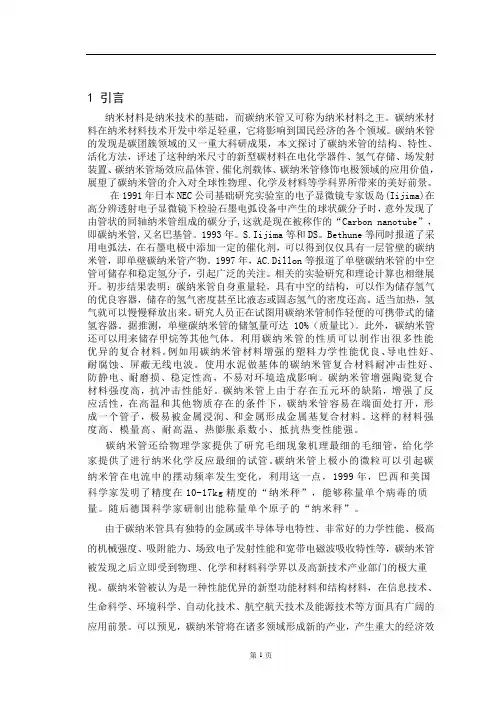
1 引言纳米材料是纳米技术的基础,而碳纳米管又可称为纳米材料之王。
碳纳米材料在纳米材料技术开发中举足轻重,它将影响到国民经济的各个领域。
碳纳米管的发现是碳团簇领域的又一重大科研成果,本文探讨了碳纳米管的结构、特性、活化方法,评述了这种纳米尺寸的新型碳材料在电化学器件、氢气存储、场发射装置、碳纳米管场效应晶体管、催化剂载体、碳纳米管修饰电极领域的应用价值,展望了碳纳米管的介入对全球性物理、化学及材料等学科界所带来的美好前景。
在1991年日本NEC公司基础研究实验室的电子显微镜专家饭岛(Iijima)在高分辨透射电子显微镜下检验石墨电弧设备中产生的球状碳分子时,意外发现了由管状的同轴纳米管组成的碳分子,这就是现在被称作的“Carbon nanotube”,即碳纳米管,又名巴基管。
1993年。
S.Iijima等和DS。
Bethune等同时报道了采用电弧法,在石墨电极中添加一定的催化剂,可以得到仅仅具有一层管壁的碳纳米管,即单壁碳纳米管产物。
1997年,AC.Dillon等报道了单壁碳纳米管的中空管可储存和稳定氢分子,引起广泛的关注。
相关的实验研究和理论计算也相继展开。
初步结果表明:碳纳米管自身重量轻,具有中空的结构,可以作为储存氢气的优良容器,储存的氢气密度甚至比液态或固态氢气的密度还高。
适当加热,氢气就可以慢慢释放出来。
研究人员正在试图用碳纳米管制作轻便的可携带式的储氢容器。
据推测,单壁碳纳米管的储氢量可达10%(质量比)。
此外,碳纳米管还可以用来储存甲烷等其他气体。
利用碳纳米管的性质可以制作出很多性能优异的复合材料。
例如用碳纳米管材料增强的塑料力学性能优良、导电性好、耐腐蚀、屏蔽无线电波。
使用水泥做基体的碳纳米管复合材料耐冲击性好、防静电、耐磨损、稳定性高,不易对环境造成影响。
碳纳米管增强陶瓷复合材料强度高,抗冲击性能好。
碳纳米管上由于存在五元环的缺陷,增强了反应活性,在高温和其他物质存在的条件下,碳纳米管容易在端面处打开,形成一个管子,极易被金属浸润、和金属形成金属基复合材料。
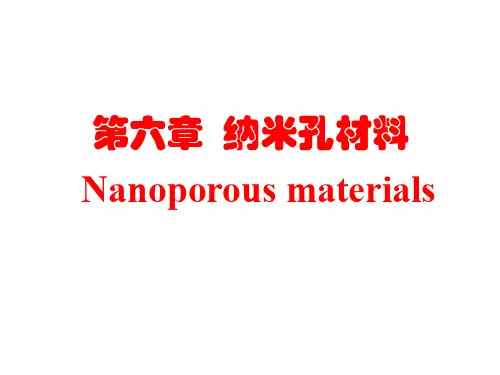
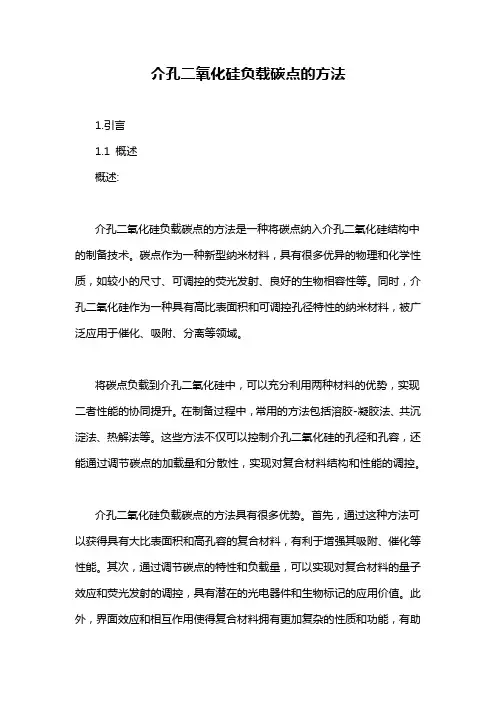
介孔二氧化硅负载碳点的方法1.引言1.1 概述概述:介孔二氧化硅负载碳点的方法是一种将碳点纳入介孔二氧化硅结构中的制备技术。
碳点作为一种新型纳米材料,具有很多优异的物理和化学性质,如较小的尺寸、可调控的荧光发射、良好的生物相容性等。
同时,介孔二氧化硅作为一种具有高比表面积和可调控孔径特性的纳米材料,被广泛应用于催化、吸附、分离等领域。
将碳点负载到介孔二氧化硅中,可以充分利用两种材料的优势,实现二者性能的协同提升。
在制备过程中,常用的方法包括溶胶-凝胶法、共沉淀法、热解法等。
这些方法不仅可以控制介孔二氧化硅的孔径和孔容,还能通过调节碳点的加载量和分散性,实现对复合材料结构和性能的调控。
介孔二氧化硅负载碳点的方法具有很多优势。
首先,通过这种方法可以获得具有大比表面积和高孔容的复合材料,有利于增强其吸附、催化等性能。
其次,通过调节碳点的特性和负载量,可以实现对复合材料的量子效应和荧光发射的调控,具有潜在的光电器件和生物标记的应用价值。
此外,界面效应和相互作用使得复合材料拥有更加复杂的性质和功能,有助于拓展其在催化、传感、能源储存等领域的广泛应用。
综上所述,介孔二氧化硅负载碳点的方法为制备具有高性能和多功能的纳米复合材料提供了一种有效途径。
随着对这种方法的深入研究和优化,相信将会有更多的应用领域受益于这种新型材料结构的发展和应用。
1.2文章结构文章结构本文主要分为引言、正文和结论三个部分。
引言部分主要对课题进行概述,介绍了介孔二氧化硅负载碳点的研究背景和意义。
同时,介绍了文章的结构,简要概括了各章节的内容和安排。
引言部分将引导读者进入整篇文章的主题,并为正文部分提供了一个清晰的背景和前提。
接下来是正文部分,其中包括了介孔二氧化硅的制备方法和碳点的制备方法。
在介孔二氧化硅的制备方法中,将介绍相关的化学合成方法和物理制备方法,并探讨各种方法的优缺点。
在碳点的制备方法中,将介绍碳点的来源以及制备过程中的关键参数和条件,并探讨不同制备方法对碳点性质的影响。

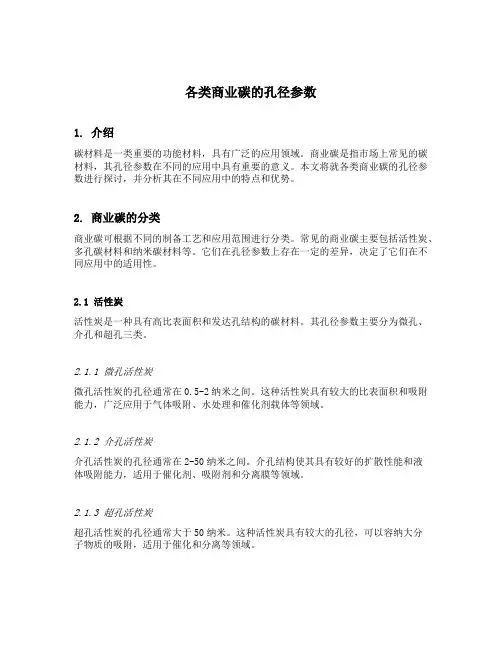
各类商业碳的孔径参数1. 介绍碳材料是一类重要的功能材料,具有广泛的应用领域。
商业碳是指市场上常见的碳材料,其孔径参数在不同的应用中具有重要的意义。
本文将就各类商业碳的孔径参数进行探讨,并分析其在不同应用中的特点和优势。
2. 商业碳的分类商业碳可根据不同的制备工艺和应用范围进行分类。
常见的商业碳主要包括活性炭、多孔碳材料和纳米碳材料等。
它们在孔径参数上存在一定的差异,决定了它们在不同应用中的适用性。
2.1 活性炭活性炭是一种具有高比表面积和发达孔结构的碳材料。
其孔径参数主要分为微孔、介孔和超孔三类。
2.1.1 微孔活性炭微孔活性炭的孔径通常在0.5-2纳米之间。
这种活性炭具有较大的比表面积和吸附能力,广泛应用于气体吸附、水处理和催化剂载体等领域。
2.1.2 介孔活性炭介孔活性炭的孔径通常在2-50纳米之间。
介孔结构使其具有较好的扩散性能和液体吸附能力,适用于催化剂、吸附剂和分离膜等领域。
2.1.3 超孔活性炭超孔活性炭的孔径通常大于50纳米。
这种活性炭具有较大的孔径,可以容纳大分子物质的吸附,适用于催化和分离等领域。
2.2 多孔碳材料多孔碳材料是指具有多级孔结构的碳材料,其孔径参数可以根据制备方法进行调控。
2.2.1 碳分子筛碳分子筛是一种由有机高聚物或低聚物为原料制备的多孔碳材料。
其孔径参数通常在0.5-2纳米之间,具有较高的孔容和选择性,广泛应用于分离、吸附和催化等领域。
2.2.2 碳纳米管碳纳米管是一种具有纳米级孔径的碳材料。
其孔径参数主要取决于管径和壁厚,通常在0.5-50纳米之间。
碳纳米管具有优异的导电性、力学性能和吸附能力,在电子器件、储能材料和传感器等领域具有广阔的应用前景。
3. 商业碳的孔径参数调控商业碳的孔径参数可以通过调控制备工艺和原料性质进行调控。
3.1 制备工艺常见的制备工艺包括活化炭法、碳化法、模板法和碳化硅法等。
这些工艺可以通过调整温度、时间和活化剂等条件来控制碳材料的孔径。
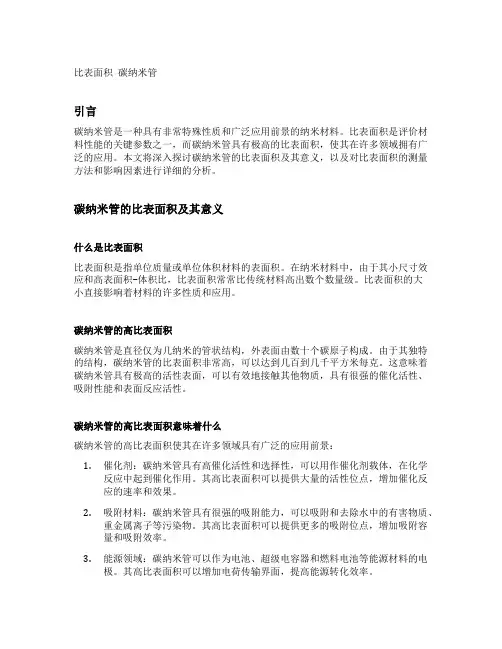
比表面积碳纳米管引言碳纳米管是一种具有非常特殊性质和广泛应用前景的纳米材料。
比表面积是评价材料性能的关键参数之一,而碳纳米管具有极高的比表面积,使其在许多领域拥有广泛的应用。
本文将深入探讨碳纳米管的比表面积及其意义,以及对比表面积的测量方法和影响因素进行详细的分析。
碳纳米管的比表面积及其意义什么是比表面积比表面积是指单位质量或单位体积材料的表面积。
在纳米材料中,由于其小尺寸效应和高表面积-体积比,比表面积常常比传统材料高出数个数量级。
比表面积的大小直接影响着材料的许多性质和应用。
碳纳米管的高比表面积碳纳米管是直径仅为几纳米的管状结构,外表面由数十个碳原子构成。
由于其独特的结构,碳纳米管的比表面积非常高,可以达到几百到几千平方米每克。
这意味着碳纳米管具有极高的活性表面,可以有效地接触其他物质,具有很强的催化活性、吸附性能和表面反应活性。
碳纳米管的高比表面积意味着什么碳纳米管的高比表面积使其在许多领域具有广泛的应用前景:1.催化剂:碳纳米管具有高催化活性和选择性,可以用作催化剂载体,在化学反应中起到催化作用。
其高比表面积可以提供大量的活性位点,增加催化反应的速率和效果。
2.吸附材料:碳纳米管具有很强的吸附能力,可以吸附和去除水中的有害物质、重金属离子等污染物。
其高比表面积可以提供更多的吸附位点,增加吸附容量和吸附效率。
3.能源领域:碳纳米管可以作为电池、超级电容器和燃料电池等能源材料的电极。
其高比表面积可以增加电荷传输界面,提高能源转化效率。
4.生物医学应用:碳纳米管可以作为药物传递、生物传感器和组织工程等领域的核心材料。
其高比表面积可以提供更大的接触面积,增加生物反应的效率和灵敏度。
碳纳米管比表面积的测量方法比氮吸附法比氮吸附法是常用的测量材料比表面积的方法之一。
该方法通过测量样品在液氮温度下吸附和解吸氮气的量来计算比表面积。
碳纳米管的比表面积可以通过此方法进行精确测量。
比氩吸附法比氩吸附法是另一种测量材料比表面积的常用方法。

多孔炭材料简介由相互贯通或封闭的孔洞构成网络结构的多孔炭材料在具备炭材料性质(如化学稳定性高、导电性好、价格低廉等)优点的同时,还具有比表面积大、孔道结构可控、孔径可调等诸多特点。
因此,多孔炭材料可应用于分离净化、色谱分析、催化、光学器件、能量存储、生物分离薄膜及纳米反应器等领域。
由三维网络结构形成的大孔结构使多孔炭材料具有优异的吸附性能。
目前,随着多孔炭材料研究的深入和应用的加快,在制备多孔炭材料时,不仅需要控制介孔材料的介观结构、孔径及孔道排列,而且对其微米级的宏观形貌也有具体要求。
现已经成功合成了球、纤维、棒、单晶和体材料等多种形貌的介孔炭材料。
一、多孔炭材料类型多孔炭材料根据孔直径大小分为三类:微孔炭材料(Micropore,<2nm)介孔炭材料(Mesopore,2~50nm)和大孔炭材料Macropore,>50nm)。
其中微孔炭材料又分为极微孔(<0.7nm)和超微孔炭材料(0.7~2nm)。
根据多孔炭材料的结构特点,又将其分为无序多孔炭和有序多孔炭材料。
其中,无序多孔炭材料的孔道不是长程有序,孔道形状不规则,孔径大小分布范围宽。
无序微孔材料中很重要的一类是分子筛型微孔炭,具有均一的微孔结构,孔直径在几A之内。
图11为模板法制备的有序多孔炭及无序多孔炭的流程图5A为不连通孔道模板制备的无序多孔炭,B为相互连通空隙模板制备的有序多孔炭。
多孔炭的微孔材料适合于吸附小分子化合物,而介孔炭材料则适合吸附分子直径较大的染料、维生素及高分子化合物等。
二、制备多孔炭材料的原材料理论上,只要能得到炭都可用作合成多孔炭的原料。
因此,制备多孔炭材料的原料种类繁多,主要有生物质材料、合成高分子材料、废弃高分子材料、焦油与煤炭材料等四类。
1、生物质材料可用作炭材料前驱体的生物质材料,既可以是植物的枝、干、叶、果实与果壳,也可以是动物的骨头和粪便,也可以来源于海洋生物(如海藻)。
枝干类材料有木材、竹、树皮、玉米芯和茎;果壳类材料有稻麦壳、核桃、椰子壳、果核、栗子壳、棉子壳等;还有蔗糖、糖蜜、咖啡豆、甘蔗渣、甜菜渣、木质素等。
(19)中华人民共和国国家知识产权局(12)发明专利申请(10)申请公布号 (43)申请公布日 (21)申请号 201910381398.0(22)申请日 2019.05.08(71)申请人 苏州十一方生物科技有限公司地址 215000 江苏省苏州市苏州工业园区金鸡湖大道99号苏州纳米城西北区12栋302(72)发明人 苏鑫 (74)专利代理机构 北京精金石知识产权代理有限公司 11470代理人 刘先荣(51)Int.Cl.B01J 27/24(2006.01)B01J 37/08(2006.01)B82Y 30/00(2011.01)B82Y 40/00(2011.01)A62D 3/17(2007.01)A62D 101/28(2007.01)
(54)发明名称一种四氧化三钴修饰介孔氮化碳纳米复合材料的制备方法(57)摘要本发明涉及纳米复合材料技术领域,特别属于一种光催化复合材料领域,具体涉及一种四氧化三钴修饰的介孔氮化碳纳米复合材料的制备方法。本发明提供一种四氧化三钴修饰介孔氮化碳纳米复合材料的制备方法,其主要特征是利用介孔氮化碳材料为基底,采用一步合成方法负载均匀分布的四氧化三钴纳米颗粒。本发明首次将四氧化三钴纳米颗粒引入介孔氮化碳,可有效降低贵金属材料光敏化剂的制备成本。该方法简单易行,所制备得的复合纳米材料在光催化等领域具有巨大的应用前景。
权利要求书1页 说明书6页 附图1页
CN 110026224 A2019.07.19
CN 110026224 A1.一种四氧化三钴修饰介孔氮化碳纳米复合材料的制备方法,其特征在于,包括以下步骤:(1)将3-氨基-1,2,4-三唑、去离子水、HCl溶液混合,搅拌至完全溶解,然后加入SiO2-H2O分散液溶液混合搅拌,得到A;(2)将A在氮气气氛中加热,然后加入NH4HF2溶液,在室温下搅拌,洗涤,干燥即可得介孔氮化碳纳米材料;(3)将介孔氮化碳纳米材料、醋酸钴和乙醇混合搅拌,然后烘干、煅烧,即可得四氧化三钴修饰的介孔氮化碳纳米复合材料。2.根据权利要求1所述的制备方法,其特征在于,各原料组分按重量份数计,3-氨基-1,2,4-三唑1-5份,去离子水5-8份,HCl溶液0.2-0.8份,SiO2-H2O分散液3-8份,NH4HF20.5-1份,醋酸钴0.2-2份和乙醇3-5份。3.根据权利要求1所述的制备方法,其特征在于,各原料组分按重量份数计,3-氨基-1,2,4-三唑3份,去离子水5份,HCl溶液0.5份,SiO2-H2O分散液6份,NH4HF20.5份,醋酸钴0.2份和乙醇3份。4.根据权利要求1所述的制备方法,其特征在于,步骤(1)中SiO2-H2O分散液的浓度为5-10wt.%,优选为8wt.%。5.根据权利要求1所述的制备方法,其特征在于,步骤(2)中NH4HF2溶液的浓度为3-5mol/L,优选为4mol/L。6.根据权利要求1所述的制备方法,其特征在于,步骤(3)中混合搅拌时间为10-14h,优选为12h。7.根据权利要求1所述的制备方法,其特征在于,步骤(3)中烘干温度为70-90℃,优选为80℃;烘干时间为5-7h,优选为6h。8.根据权利要求1所述的制备方法,其特征在于,步骤(3)中煅烧温度为280-320℃,优选为300℃;煅烧时间为1-3h,优选为2h。9.根据权利要求1所述的制备方法,其特征在于,步骤(3)中煅烧气氛为氧气气氛。10.根据权利要求1所述的制备方法,其特征在于,包括以下步骤:(1)将3-氨基-1,2,4-三唑、去离子水和、HCl溶液混合,在40-60℃下搅拌3-8min至完全溶解,将其与SiO2-H2O分散液混合,在70-90℃下搅拌1-3h,得到A;(2)将A加热,以10℃/min升温速度升至450-550℃,在氮气气氛中保持3-5h;然后用NH4HF2溶液处理,室温下搅拌20-28h,用去离子水和乙醇洗涤,然后在70-80℃下干燥10-14h,即可得介孔氮化碳纳米材料;(3)将介孔氮化碳纳米材料、醋酸钴和乙醇混合搅拌10-14h,然后70-90℃条件下烘干5-7h、280-320℃条件下煅烧1-3h,即可得四氧化三钴修饰的介孔氮化碳纳米复合材料。